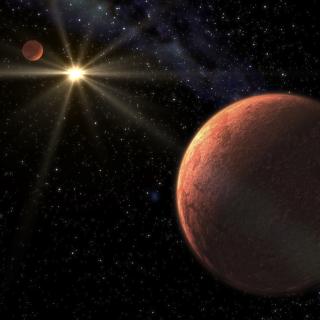Bibcode
Passegger, V. M.; Reiners, A.; Jeffers, S. V.; Wende-von Berg, S.; Schöfer, P.; Caballero, J. A.; Schweitzer, A.; Amado, P. J.; Béjar, V. J. S.; Cortés-Contreras, M.; Hatzes, A. P.; Kürster, M.; Montes, D.; Pedraz, S.; Quirrenbach, A.; Ribas, I.; Seifert, W.
Referencia bibliográfica
Astronomy and Astrophysics, Volume 615, id.A6, 11 pp.
Fecha de publicación:
7
2018
Revista
Número de citas
109
Número de citas referidas
97
Descripción
Context. The new CARMENES instrument comprises two high-resolution and
high-stability spectrographs that are used to search for habitable
planets around M dwarfs in the visible and near-infrared regime via the
Doppler technique. Aims: Characterising our target sample is
important for constraining the physical properties of any planetary
systems that are detected. The aim of this paper is to determine the
fundamental stellar parameters of the CARMENES M-dwarf target sample
from high-resolution spectra observed with CARMENES. We also include
several M-dwarf spectra observed with other high-resolution
spectrographs, that is CAFE, FEROS, and HRS, for completeness.
Methods: We used a χ2 method to derive the stellar
parameters effective temperature Teff, surface gravity logg,
and metallicity [Fe/H] of the target stars by fitting the most recent
version of the PHOENIX-ACES models to high-resolution spectroscopic
data. These stellar atmosphere models incorporate a new equation of
state to describe spectral features of low-temperature stellar
atmospheres. Since Teff, logg, and [Fe/H] show degeneracies,
the surface gravity is determined independently using stellar
evolutionary models. Results: We derive the stellar parameters
for a total of 300 stars. The fits achieve very good agreement between
the PHOENIX models and observed spectra. We estimate that our method
provides parameters with uncertainties of σTeff = 51 K,
σlog g = 0.07, and σ[Fe/H] = 0.16, and
show that atmosphere models for low-mass stars have significantly
improved in the last years. Our work also provides an independent test
of the new PHOENIX-ACES models, and a comparison for other methods using
low-resolution spectra. In particular, our effective temperatures agree
well with literature values, while metallicities determined with our
method exhibit a larger spread when compared to literature results.
Full Table A.1 is only available at the CDS via anonymous ftp to http://cdsarc.u-strasbg.fr (http://130.79.128.5) or via http://cdsarc.u-strasbg.fr/viz-bin/qcat?J/A+A/615/A6
Proyectos relacionados

Estrellas de Baja Masa, Enanas Marrones y Planetas
Se investigan los procesos que conducen a la formación de estrellas de baja masa, enanas marrones y exoplanetas y caracterizar las propiedades físicas de estos astros en varias etapas evolutivas. Las estrellas de muy baja masa y las enanas marrones son probablemente los objetos más numerosos de nuestra Galaxia, pero no por ello están
Rafael
Rebolo López

Exoplanetas y Astrobiología
La búsqueda de vida en el Universo se ha visto impulsada por los recientes descubrimientos de planetas alrededor de otras estrellas (los llamados exoplanetas), convirtiéndose en uno de los campos más activos dentro de la Astrofísica moderna. En los últimos años los descubrimientos cada vez más numerosos de nuevos exoplanetas y los últimos avances
Enric
Pallé Bago